Chicago has a curious, almost smug, attitude toward abstract art. Simply put, the city is totted as a bastion for narrative driven fine art. For some, the aesthetic practices of the Hairy Who and Chicago Imagists (dating back to the late 1960s) still rule the roost. Nevertheless, there have been artists of note who have worked within non-narrative formats, advanced relevant investigations, and found success here in the windy. Corey Postiglione has been cultivating an intelligent and rigorous Minimalist sensibility since the early 1970s. His practices continues to evolve today. This past May, Postiglione retired from teaching art theory and studio practices at Columbia College Chicago after a long career that has influenced countless artists working today. The COMP Magazine recently sat down with Postiglione in his Ravenswood studio to discuss his relationship to the city, the value of the tactile aspects in painting, and his ongoing visual investigations based upon the tango.
Can we start with your relationship to the city? You’ve been making serious work and teaching aspiring artists for over 30 years. Are there any tenets that have persisted during this time? Has the art scene expanded/contracted during your tenure? Is there anything you miss?
As it turned out Chicago was not the place for my art. I began as a minimalist which was so contrary to what was promoted here in the late 60s and 70s, that is the imagist style i.e, Ed Paschke, Jim Nutt. But having said that, a small group of us that were working abstractly had a certain notoriety in the 70s. We were getting shows at galleries like Richard Gray and Nancy Lurie.
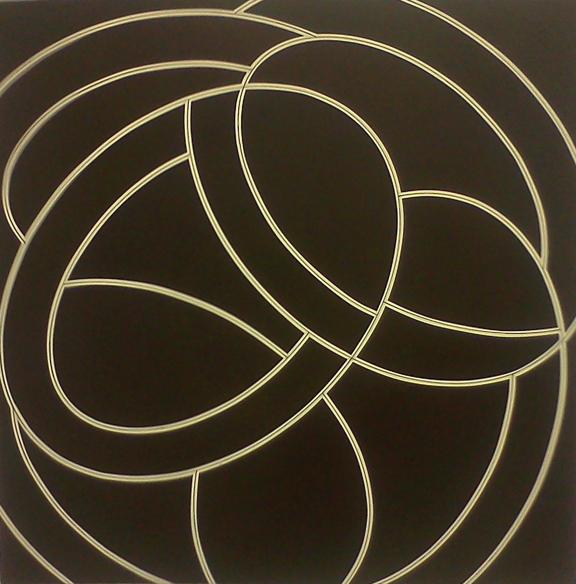
Corey Postiglione, Black & White, acrylic on canvas, 24″ square, 2015
You’ve been working on a series of drawings and paintings rooted rhythmically in relationship with the tango. Can you describe the inception of this work? Where has your investigation taken you?
The Tango series began as an offshoot of the labyrinth series from the 90s. Basically my agenda for a long time was to make abstract work that was metaphoric, connected in some way visually to the life world. In the Tango works I used semiotically geometric abstraction from the 60s, like Frank Stella as a style but resignified it with a new content. This was inspired by Peter Halley’s work from the 90s where he was borrowing 60s hardedge abstraction. I called it the Tango series because it visually referenced complexity and entanglement, it was also a play on words. But the dance itself is actually very complicated with the dancers moving into each other’s space. For this effect I used a series of intertwined ovals. One more thing about the content: I wanted the work to simulate or reflect the global world and how we try to find ourselves in it. It is still the idea of the labyrinth—lost and confused.
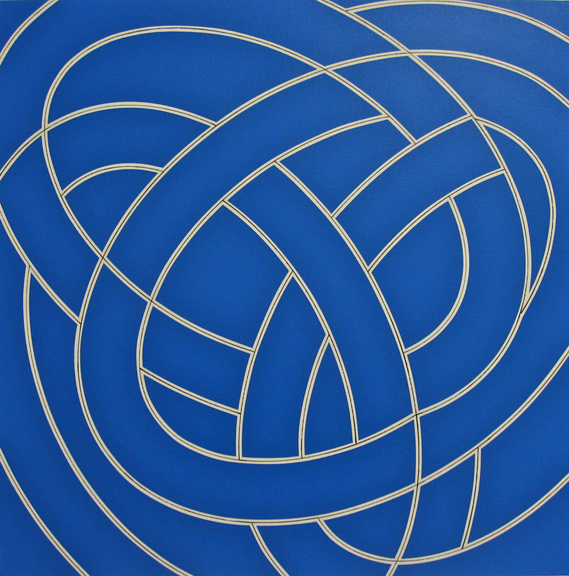
Corey Postiglione, Tango Spectrum, acrylic on canvas, 2014
What do you value in the process of painting?
I have always seen myself as a painter; I enjoy process and material and hands on work. I have always said in reference to the conceptual aspects of the medium: when you make a painting you are making at times a thousand critical decisions. It gives me great pleasure to make something and make it with precision and difficulty—at least for me. I have to have a concept and a system before I begin. This is probably leftover from my minimalist days.
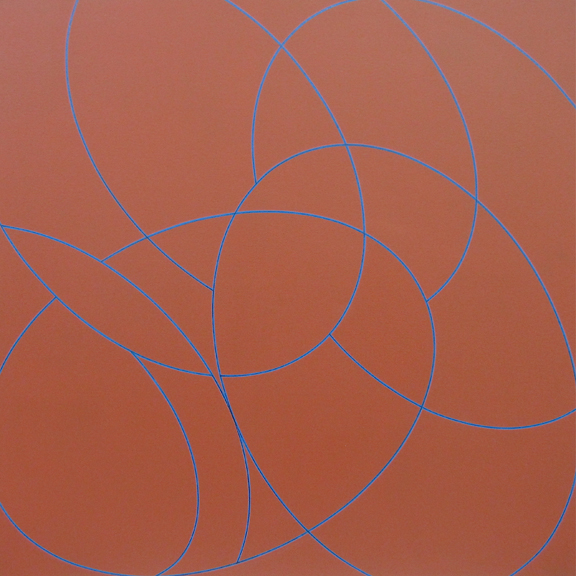
Corey Postiglione, Lines of Flight #6, acrylic on canvas, 30″ square, 2014
You teach art theory and tend to truly enjoy heady discussion when discussing the visual arts. How do you balance this with the tactile aspects of your work?
This is an important question. The balance can be difficult at times. With art theory you can become to self conscious about what you are making. I remember when I got out of grad school (SAIC) where we focused on theory I didn’t make work for a couple of years. Every time I thought about a visual work, I felt it was just illustrating theory. Finally I was able to overcome this and found a way to express some of the ideas in a more poetic sense, more open to interpretation. This actually took off from an essay by Fredrick Jameson and his challenge to artists to map the postmodern. This began the Labyrinth series in 1990. So in a round about way of answering your question teaching theory and making work feed each other. But studio time is always what has to be negotiated.
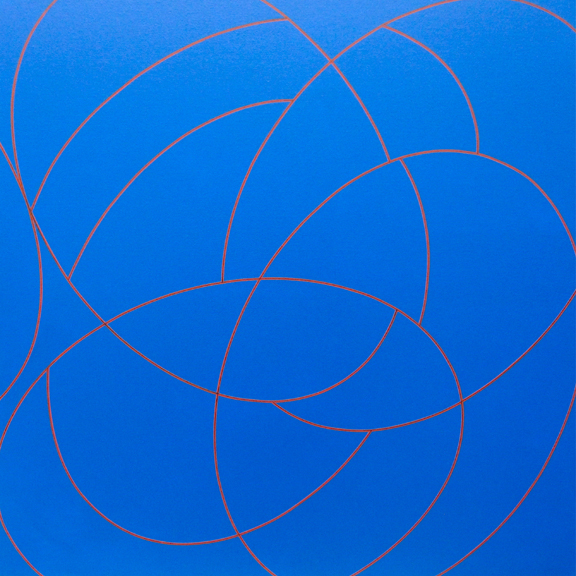
Corey Postiglione, Lines of Flight #7, acrylic on canvas, 30″ square, 2014
You’ve been collaborating with your wife, the painter Kathie Shaw, in recent time. Can you share with us what the two of you have been working upon? Do you see any differences in your approach or application when working collaboratively?
We have done a couple of collaborations for specific shows. We have usually used a diptych format so that we could retain our individual styles but at the same time make them cohesive (see image). Our grater collaboration is just working together in the studio where we critique work in progress or just have a running dialogue.
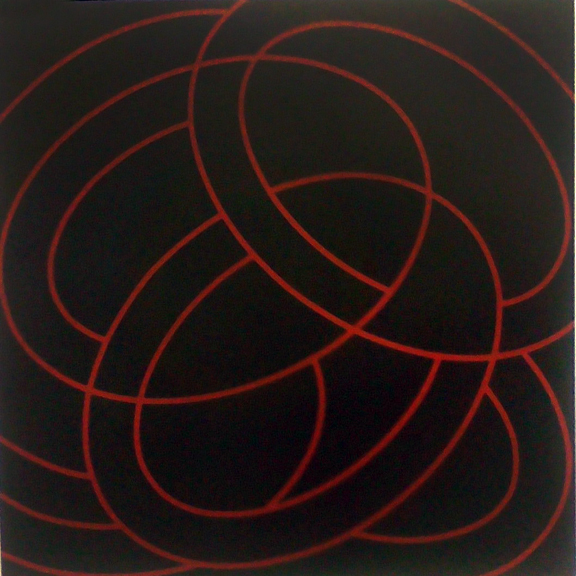
Corey Postiglione, Black & Red, acrylic on canvas, 24″ square, 2015
What are you currently working upon? Are there any upcoming exhibitions we should keep our eyes on the lookout for?
I am always trying to invigorate the work with new formal ideas; that is innovations on the series that are already part of my oeuvre. At this time I am working on a series of black paintings for the eponymous show to be held at Space Gallery in Denver in October. There will be five canvases (2 feet sq.) with each black a different hue—some mixed with red or ochre for example. The under color for each canvas will also be different and will be only revealed in the linear design (see images).
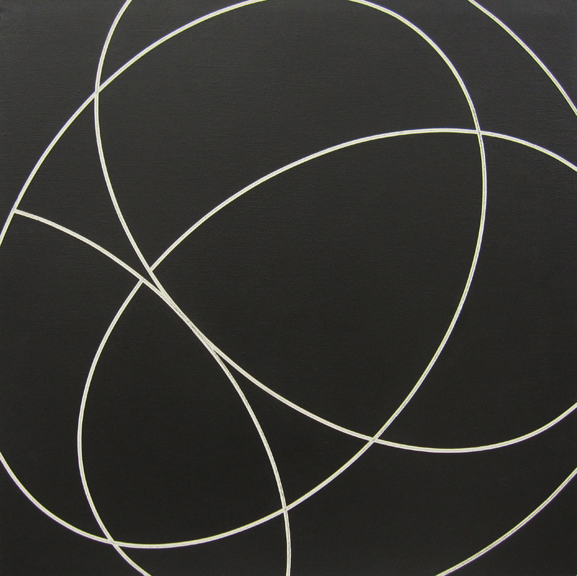
Corey Postiglione, Lines of Flight #,3 acrylic on canvas, 18″ x 22″, 2014
For additional information on the work of Corey Postiglione, please visit:
Corey Postiglione – http://coreypostiglione.com/home.html
Thomas Masters Gallery – http://www.thomasmastersgallery.com/artist_view/?id=84
Space Gallery – http://spacegallery.org/artist/corey-postiglione/
Ro Gallery – http://rogallery.com/Postiglione_Corey/postiglione-biography.html
Oaken Community College – https://www.oakton.edu/about/thearts/museum/past_exhibitions/corey_postiglione.php
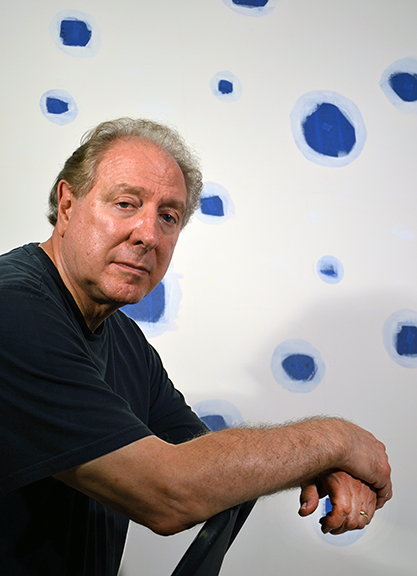
Corey Postiglione, painter, Chicago, 2014
Interview and portrait by Chester Alamo-Costello


